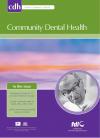Community Dental Health

- Cover Date:
- June 2008
- Print ISSN:
- 0265 539X
- Vol:
- 25
- Issue:
- 2
Dental caries rates in primary teeth in 2002, and caries surveillance trends 1981-2002, in a South African city.
Objective To determine trends in the prevalence and severity of dental caries in 2- to 5-year-old children. Basic research design Repeated cross-sectional surveys in 1981, 1983, 1985, 1987, 1989, 1991, 1994, 1997 and 2002. Clinical setting Nursery schools in Germiston, South Africa. Participants Dental caries was diagnosed by calibrated examiners using WHO criteria in 7,185 2- to 5-year-old children whose parents had given informed consent. Main outcome measures Caries prevalence (%), caries experience (dmft). Results Both caries prevalence and experience showed statistically significant (p<0.001) fluctuations between study years from 1981 to 2002. A worry is an increase in rates between 1997 and 2002. Conclusion There is a suggestion of a cyclical pattern to the caries rates observed.
Key words: caries prevalence, dental caries, dental epidemiology, dmft, surveillance
- Article Price
- £15.00
- Institution Article Price
- £
- Page Start
- 79
- Page End
- 83
- Authors
- P. Cleaton-Jones, S. Williams, C. Green, P. Fatti
Articles from this issue
- Title
- Pg. Start
- Pg. End
- Editotial - Do we let children’s teeth decay just because some people object to topping up the natural fluoride that’s already in our water?
- 66
- 69
- Dental caries rates in primary teeth in 2002, and caries surveillance trends 1981-2002, in a South African city.
- 79
- 83
- Individual and maternal determinants of self–reported dental health among Turkish school children aged 10-12 years.
- 84
- 88
- Comparison of ranking dental status using the Significant Caries Index and the Significant Filled and Sound-Teeth Index
- 103
- 106
- Measuring oral health behaviour in Flemish health care workers: an application of the Theory of Planned Behaviour
- 107
- 114
